Hockey is one of the fastest sports in the world. In this article, I’m going to teach you exactly how to reach your next level of speed out on the ice.
Hockey presents several unique movement demands that no other sport has to deal with.
First, hockey is played on ice with skating as the mode of locomotion. Wearing skates instantly changes the lower body mechanics driving your performance in comparison to almost all other sports, where your feet are directly connected to the ground.
Second, the speed at which hockey players move out on the ice exceeds any other team sport. Hockey is a high-velocity sport requiring acceleration, deceleration, abrupt stops, and explosive starts all game long.
Third, a hockey player will play 12–22 shifts per game, each lasting up to a minute in length, with varying degrees of high and moderate intensity conditioning outputs during the shift. While on the ice, a hockey player needs access to all of their physical tools as they may need to use high-level speed, conditioning, agility, coordination, and reaction time—all in less than a minute.
When it comes to breaking through your current speed plateau, you need to consider the three main pillars of SAQ training (speed, agility, quickness).
Pillar #1: Stabilization and Deceleration
This pillar can sound counterintuitive to some players and coaches because it’s easy to think that “stable” means still, and that “deceleration” means slow—and no one wants to train stillness and slowness!
Luckily for us, that’s not what these terms actually represent. Instead, stability represents control, and deceleration represents your ability to absorb and redirect forces.
Stability must come before deceleration, because it is stability that allows you to remain coordinated at high velocities.
Imagine if a very fast hockey player lacked stability. They would be an out-of-control mess, and their skating technique would dramatically suffer (not to mention how a lack of stability puts you at major risk for an injury when skating fast).
Stability is best built through core training modalities; these exercises would be a great place to start:
Deceleration must also be trained and is a critical component to improving your overall speed and agility out on the ice. (Agility, put very simply, is your “stop–start” speed. It represents your ability to maintain speed or momentum during high-velocity direction.)
When your decelerative strength is at an elite level, you can absorb high levels of force and instantly redirect them—in contrast to your opponents, who will need to slow down in order to be able to handle the forces being placed on them.
For example, if you are skating at your top speed and you have a high level of decelerative strength, you will be able to stop or change directions instantly.
Alternatively, your opponent who hasn’t trained his decelerative strength will have to either perform an awkward stutter-stop as they skip along the ice, or slow their speed down dramatically before they stop or tries to change direction.
Having higher levels of decelerative strength will put you 3–5 strides ahead of your opponents who have never heard of this concept. This is good for you, because 3–5 strides is an eternity out on the ice and will separate you from the pack in a way that no other type of training can.
Deceleration is best trained through utilizing deceleration-specific dryland training drills within your speed programming. These should give you a great idea on where to start:
Pillar #2: Lateral Power, Change of Direction Speed, and Mental Agility
A hockey athlete’s ability to change their initial direction to a predetermined location and space on the ice (or the track/field since dryland work is where we will be doing most of our agility training) is known as Change of Direction Speed (CODS).
However, in addition to the physical ability to change direction, it is the perceptual–cognitive ability to react to a stimulus such as the defensemen or the movement of the puck that provides a true definition of agility.
In many sports, including hockey, athletes do not have the time nor the open space to reach true top speed levels during a game.
The constant chaos of reacting to the game and playing on a surface as small as a standardized rink requires hockey players to decelerate and then reaccelerate in another direction as rapidly as possible whilst maintaining or regaining as much momentum as possible.
Agility and kinesthetic body awareness is relevant for all hockey athletes, as this readjustment of the athlete’s momentum can occur during either an offensive, defensive, or goalie-specific task.
Plenty of research has indicated that an athlete’s lower-body response time may differ depending on whether the athlete’s stimulus-response requirement (tactical situation) is offensive or defensive.
The exact reason for these varying response times is not yet known; however, the processing strategy (which varies depending on gender and environment) can influence the time it takes a hockey athlete to physically and cognitively respond to the situation.
Interestingly, scientists have hypothesized that offensive response requires information to move across both hemispheres of the brain, whereas defensive response allows the processing to occur on only one side.
This may sound overwhelming, but the conclusion is surprisingly common-sense: just like you would train both the left and right side of the body, hockey athletes should utilize drills that require processing across both hemispheres of the brain.
This creates “balance” in your mental agility, which translates to greater balance in your physical agility.
When you combine this type of training methodology with lateral power development, you train movement in a way that is truly cutting edge and unique to hockey players.
Lateral power and movement drills improve your stride length and stride frequency, whereas CODS drills that incorporate both mental and physical agility enhance your “real-time” decision-making speed out on the ice.
Here are some example drills to show you what this looks like in real programming practice:
Pillar #3: Complete Speed Development
I refer to pillar #3 as “complete” because most people only refer to speed as a single characteristic that hockey players have.
Yet, from a sports science perspective, there are very distinct ways in which you can train the various types of speed.
To have true complete speed development, you need a well-rounded combination of capabilities:
- Starting speed (first-step quickness and explosiveness)
- Acceleration (how quickly you can get to top speed—ideally in as few strides as possible)
- Top speed (how fast you can move once you have reached your all-out top speed out on the ice)
Tying these three components together creates an explosive athlete who is able to reach their top speed out on the ice in only a few strides—where nobody can catch them.
Differentiating between starting speed, acceleration, and top speed is very important because many athletes are good in one or two categories, but almost all hockey players are held back by being average or slightly below average in at least one of these categories.
Some hockey players are explosive but lack top speed. Other players have top speed but lack the first step quickness and acceleration they need in tight situations.
Elite NHL players like Connor McDavid don’t have any weaknesses within the speed department. He is extremely explosive and seems to be at top speed after only just a few strides out on the ice. This immediately separates him from the pack and allows him to perform at an extremely high level no matter what the on-ice circumstances.
I discuss this type of speed training methodology and how you can achieve “complete” speed development within this popular workout video:
Connecting the Pillars for Ultimate Hockey Programming
Each of the above three pillars carries its own unique science, drills, and program design strategies. However, they all play into the same end goal of having unstoppable speed out on the ice.
The perfect hockey training programming concoction develops NHL-like movement abilities out on the ice:
- The stabilization and deceleration to remain coordinated and technically efficient even at the highest velocities with instantaneous direction change
- The lateral power and mental/physical agility to increase your hockey IQ and maximize both your stride length and stride frequency
- The complete speed development you need to blow by your opponents in all game scenarios
With that said, there is some equipment you will want to help you maximize your improvement in the shortest time frame possible. The best part is that you only need three pieces of equipment—and they are lightweight and easily transportable to any training environment.
Edge Work Enhancer Ladder
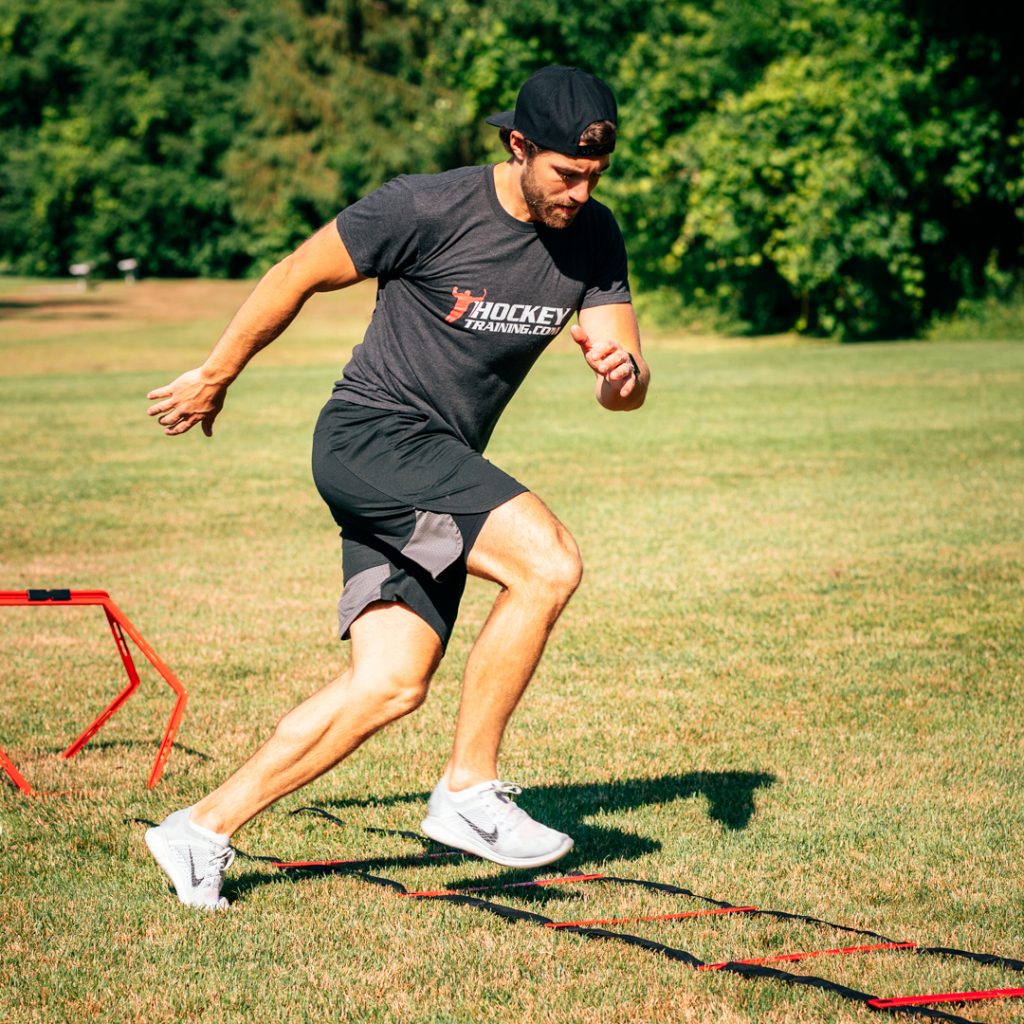
Elite hockey athletes must create a stable balance around their ankles, because the greater amount of force the ankles can safely absorb and produce results in their ability to transfer into better edge work and overall better skating.
In addition to lower body force production, strengthening the stabilizing muscles around the ankles helps prevent chronic issues associated with high-velocity motion such as shin splints and tendonitis.
Lastly, and perhaps most importantly, increased ankle stability leads to enhanced proprioception, which is the body’s ability to realize its place in space (think of having better “body awareness” out on the ice).
If you’re unable to stabilize the ankle joint structure while skating, the body will send alert signals to the brain warning that the tissue structure is in danger.
(You can think about it like how your body warns you before you drop down too low into the splits: it lets you know, “Hey! You’re going to get injured if you go further than this.”)
Proprioception is a safety measure the body has to limit optimal ranges of motion to prevent you from creating deep angles on your inside/outside edges, and thus, reduce your skating potential.
Elite skaters like Sidney Crosby don’t have these warning signals in place because their ankle stability can both absorb and redirect very high levels of force. You regularly see him hit excellent edges on a moment’s notice and easily slip in and out of mohawk turns.
Ankle stability leads to superior proprioception, and superior proprioception leads to superior balance and awareness during high-speed movement.
No tools train ankle stiffness and coordination better than the speed ladder, which is why I am a huge fan of including them within the program design of athletes who have access to them.
Not to mention, they have a huge variety of applications that can be used in any one of the three pillars above. It is a very versatile tool and one I think should be in every serious hockey player’s toolkit.
Explosive Speed Rings
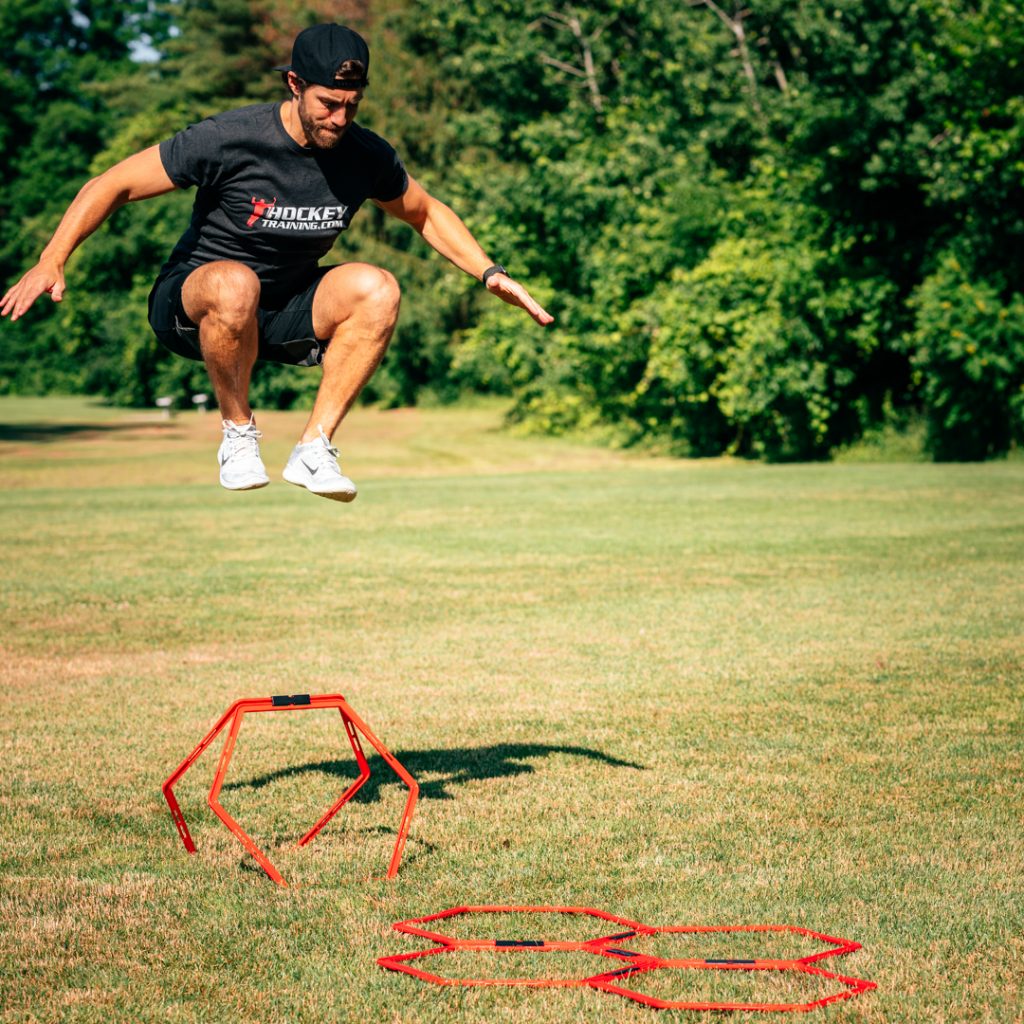
These explosive speed rings are a 3-for-1 bonus for hockey players because of their versatility.
You can lay them flat to perform dozens of different edge work and plyometric drills (excellent for that first step quickness we discussed above).
Or stand them up and connect them together to create mini-hurdles used for the most explosive type of plyometric training that all hockey players should be doing.
The hurdles are an excellent way to tackle the complete speed development department through various power highways:
- Vertical power based exercises are excellent for explosive starting speed and acceleration
- Horizontal power based exercises are excellent for deceleration and top speed training
- Lateral power based exercises maximize your stride length and stride frequency
These three “power highways” are best trained using the objective measures that the hurdles provide you.
Lastly, we use them as markers/cones for many of our hockey speed drills – eliminating the need to carry around another piece of equipment (cones) for your training.
This is a lot of boxes being checked with only one item, and it too can be very effectively programmed into your hockey training no matter what pillar you are working on.
Hockey Reaction Ball
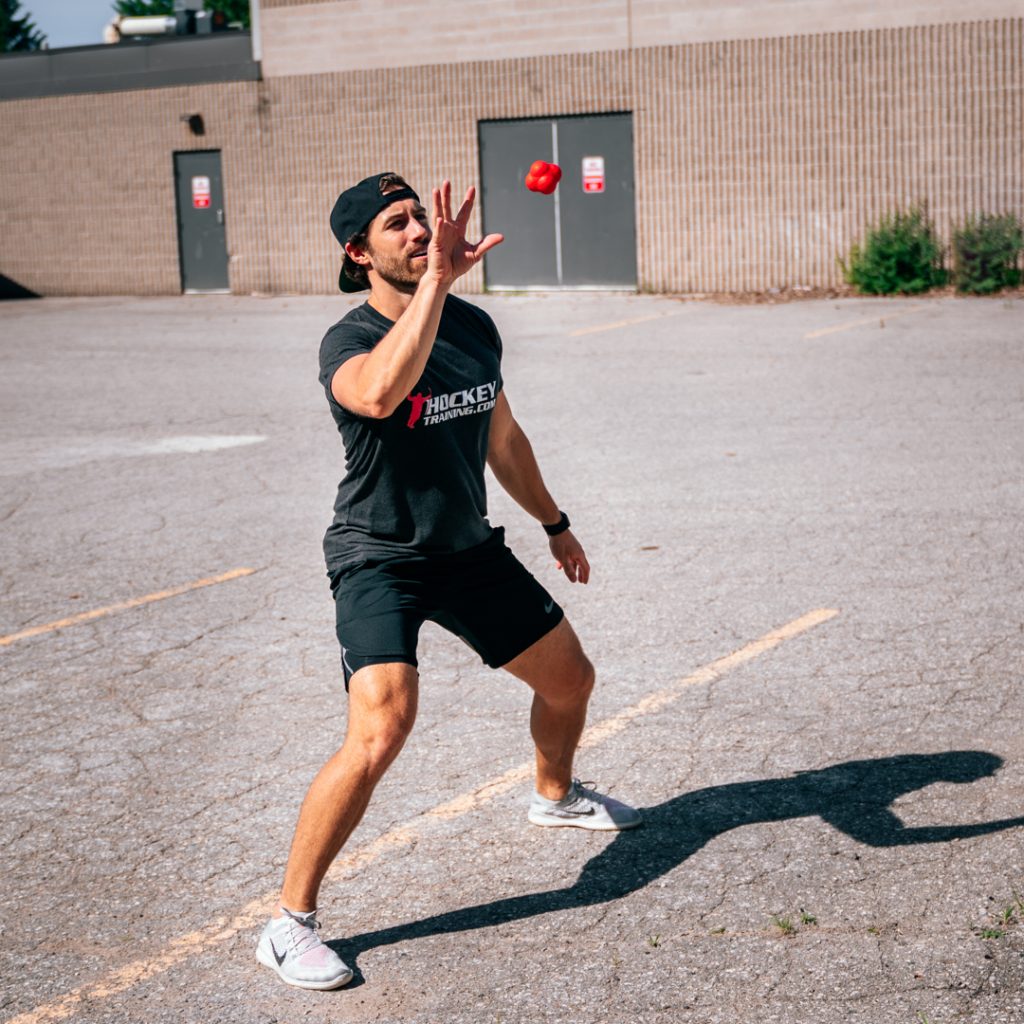
Although this tool may seem simple on the surface, there are a wide variety of drills that you can include in any speed, agility, or conditioning workout to add a mental component to your training.
The lopsided nature of the reaction ball design forces it to bounce in unpredictable patterns. This is a simple and effective way to optimize the “mental agility” pathways we discussed above regarding the optimization of your reaction time as well as both your offensive and defensive awareness.
This is something so many hockey players forget—yet, if you talk to any NHL player, one of the first things they will tell you is how much of the game is mental rather than physical. Your mind is a tool just like anything else in your body: it can and SHOULD be trained on a regular basis!
Even Wayne Gretzky was famous for saying, “I skate to where the puck is going to be, not where it has been.”
The reaction ball is an effective way you can simultaneously train your mind and your body at the same time, so you can achieve that mind-body connection you need to become a better hockey player.
Athletic Movement Bands
Increasing in resistance the further you go, bands are great to challenge ankle inversion and eversion for elite edgework, which is very difficult to do without a proper band (and by difficult, I mean next to impossible).
I also use them as my go-to for groin and glute training because they create a stronger stride while simultaneously providing a significant injury reduction benefit. For example, research has demonstrated that professional hockey players are 17x more likely to sustain a groin injury when their adductor strength was less than 80% of their abductor strength.
Bands allow you to target the groin directly, thus, dramatically reducing your risk for injury out on the ice. Additionally, since they are excellent at isolating the gluteus maximus and medius, you can directly target two of the largest muscle groups involved in generating an explosive skating stride.
Lastly, since the tension can be selected at a low amount of resistance, it gives you something to do on your recovery days to help you become a better hockey player without detracting from the recovery you need to perform in games, practices, and more intense dryland training sessions.
Skater Sliders
There are many reasons I like sliders, but on the top of the list is the apparent translation they have toward allowing you to mimic a skating stride at home.
Whether through stationary slider skating strides or sliding lateral lunges, you can target the lateral musculature responsible for skating speed in hockey players in a more effective way than if you were to try and do these movements without a slider. This is especially true for plantar flexion reps, which improve stride length propulsion and are impossible to do without them.
Equally important but less well-known is how large of an impact the core has on speed development. The function of the core in speed development represents itself in agility through a faster change of direction speed due to improved force absorption and redirection in the deceleration and acceleration phases.
Additionally, the core “unlocks” speed development. When your core is weaker than your lower body your nervous system will shut down maximum fiber recruitment in the lower body as a protective mechanism to reduce injury risk in the upper body. Just like you wouldn’t want to shoot a cannon out of a canoe because the foundation isn’t strong enough to keep you safe, the nervous system shuts down speed output using the same ideology.
A strong core equals better agility and higher speed outputs due to both improved force output and reduced inhibition, and the skater sliders are one of the best tools in the book to get the job done.
They’re also easy to transport and hockey-specific, you can’t ask for much more than that.
Balance Foam Pad
Most hockey players and parents associate speed development with the fast-paced, explosive type of dryland training. However, that type of high-velocity work will never reach its potential to positively impact your game if you don’t have the balance and ankle stability to support it.
Balance and stability training for edge work mechanics can vary from mildly difficult (e.g., bodyweight squats on foam pad) to extremely difficult (e.g., T-Stand on foam pad), so it can be effectively incorporated into a warm-up, workout, or cool-down.
When you stand on the pad, you immediately feel the effects of forced instability and how your functional tissues need to activate and adapt to create new levels of dynamic balance.
Since this will contribute to a vast range of performance metrics and be very low-impact during times of injury or recovery, this is a no-brainer for any hockey player to have in their arsenal.
The Solution To Become A Blazing Fast And Explosive Skater
Pictured above is our brand new Breakaway Speed Kit that we just launched to help hockey players of all ages who want to improve their explosive skating speed!
The kit includes the six hockey speed tools we talked about earlier and our brand new 30-Day Breakaway Speed System…
The all-new 30-Day Breakaway Speed System was designed to take all of the guesswork out of it for you so you can train with the most cutting-edge methods to get serious results.
This is an intense 30-day progressive SAQ training approach that includes weekly speed, agility, endurance, and conditioning workouts to become an elite skater…
You will get access to the comprehensive 30-day schedule that shows you exactly what to do each day…
And you will be performing each of your high-level workouts with your new Edge Work Enhancer Ladder, Explosive Speed Rings, Athletic Movement Bands, Skater Sliders, Balance Foam Pad and Hockey Reaction Ball…
So you can train just like the top NHL players (no matter your age)!
Remember, if your hockey speed isn’t where you want it to be, it’s not your fault…
Real speed progress comes from real hockey-specific training and this type of programming only comes from a hockey performance specialist…
That’s why each and every workout has been formulated with Beginner, Intermediate, or Advanced training options…
So that no matter where you are currently at in your hockey training journey you will be able to see dramatic results after only 30-Days of using the Breakaway Speed System and the advanced training tools found in your Breakaway Speed Kit.
The best part?
This new 30-Day Breakaway Speed System can be used as a standalone program or be added to the existing program you’re currently running so that you can get better results no matter what your current training schedule looks like…
Your days of guessing and hoping you will be a better hockey player are over…
Get started with the 30-Day Breakaway Speed System today so you can leave fans, coaches, and scouts jaws on the floor with how much progress you have made in a single month of training. Click here to get the Breakaway Speed Kit today!
Final Thoughts
I hope I was able to articulate the unique design of a true hockey-specific speed training system and how important it is to understand the three pillars of unstoppable speed and use the right training tools at the right time for the best results.
Many hockey athletes don’t improve their performance very much from year to year, and the primary reason this happens is that they routinely overlook the complexity behind real hockey training program design.
Let me tell you something: you’ve been lied to. The hardest worker in the room does NOT always get the best results. Instead, it’s the athlete who is able to put their efforts into the most intelligent areas for hockey performance enhancement who is going to win in the end.
Why?
Because no matter how hard you work on a sub-optimal program, you’re still going to receive suboptimal results.
Be the hockey player who puts their efforts into an optimal hockey training program and blows their competitors away next season by jumping on the 30-Day Breakaway Speed System here.

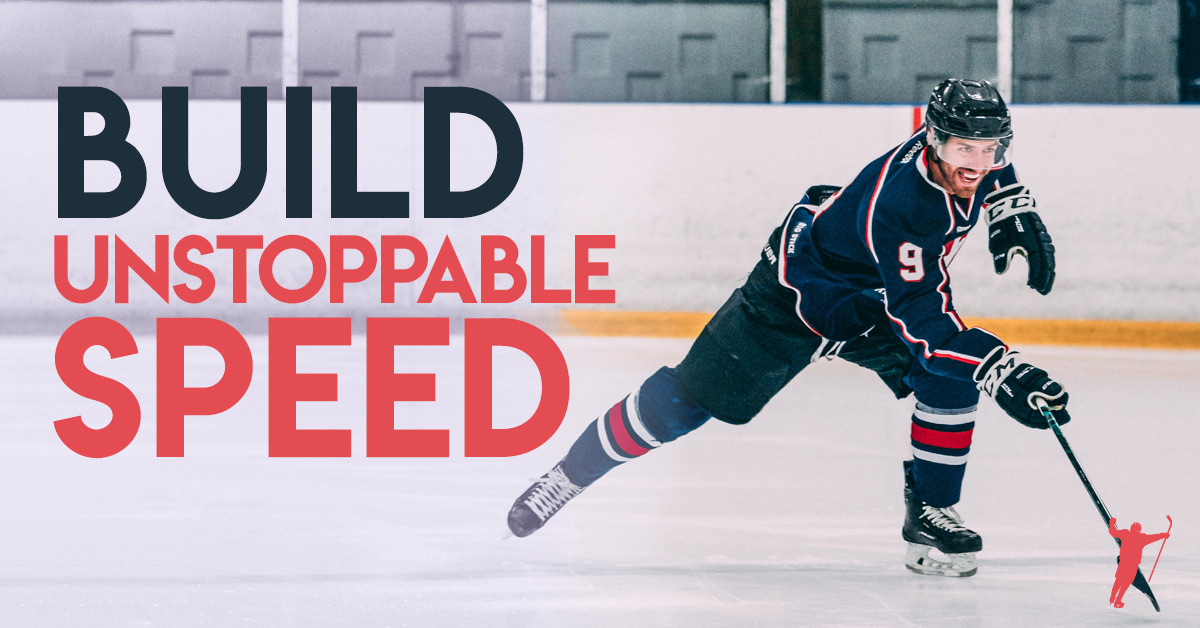

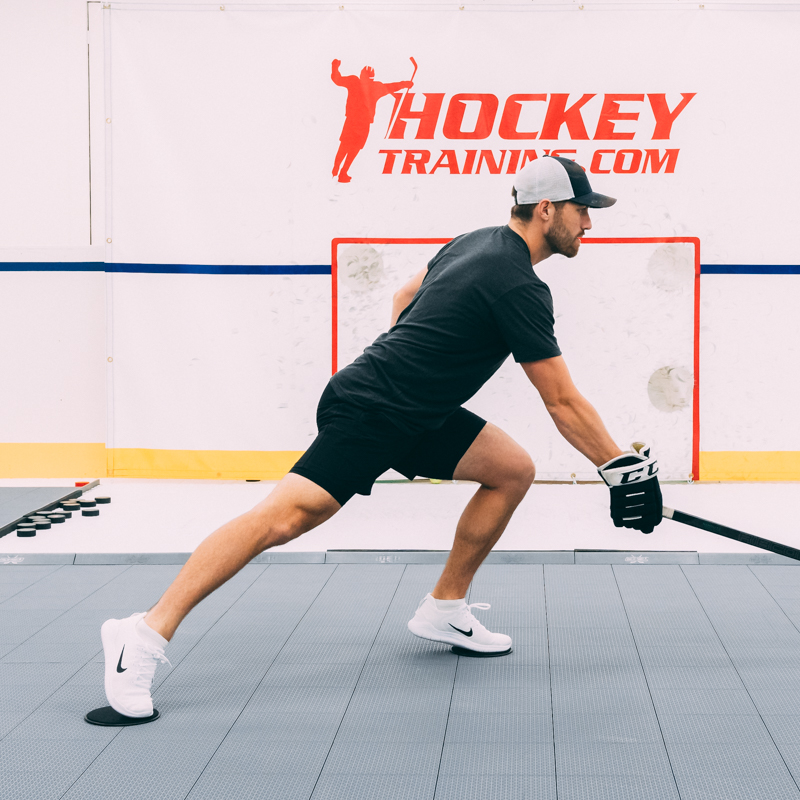


Thank you for these great videos / training. Cheers from SLovakia. P
These are great and I look forward to incorporating them regularly into my training, which is already a mix of agility, strength, endurance and stretching (from Olympic and 1/2 IM competitions in the late spring, summer and early fall, to hockey in the late fall, winter and early spring, with skiing mixed). Even a 58-year old can still improve. Thanks!